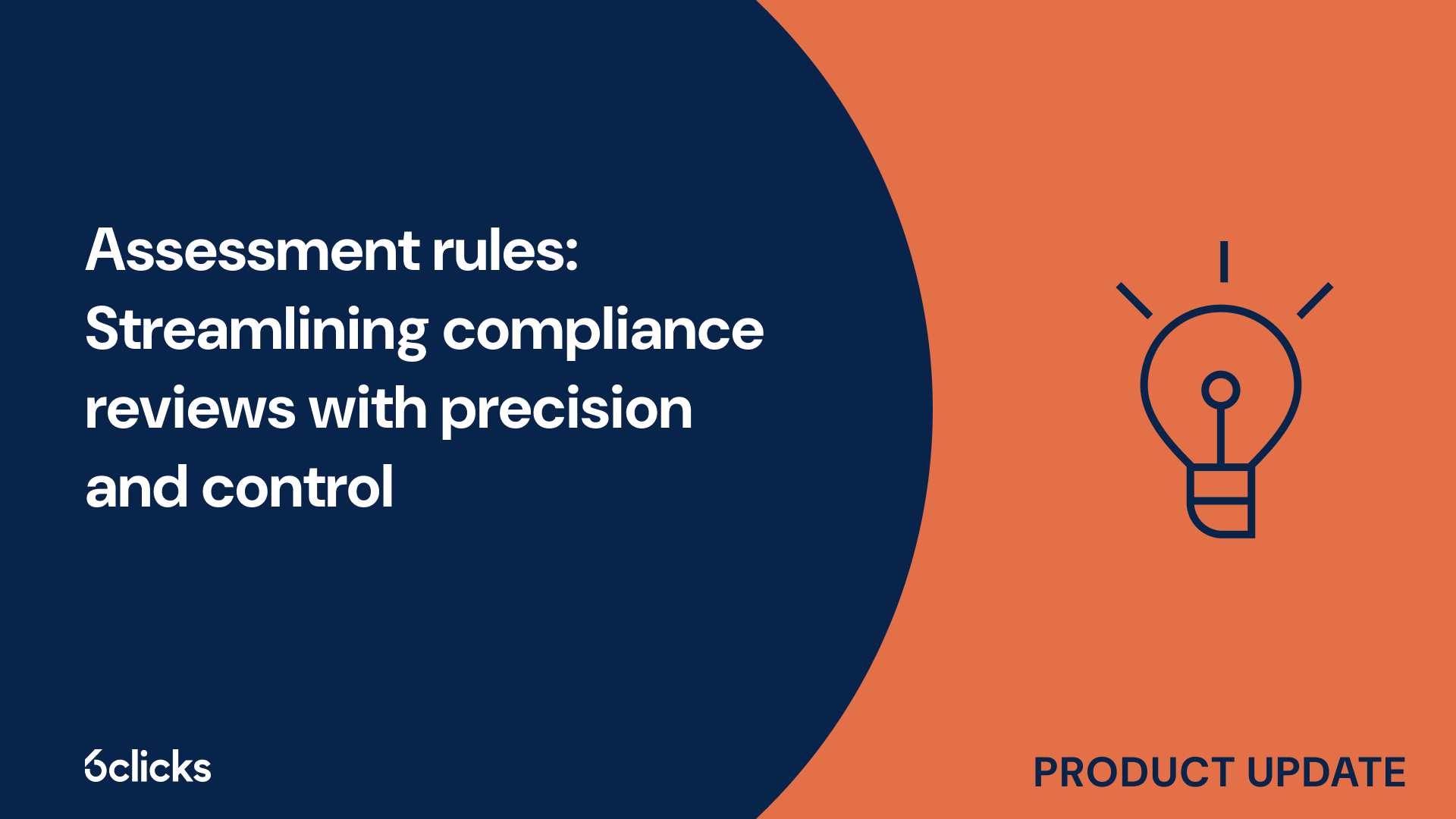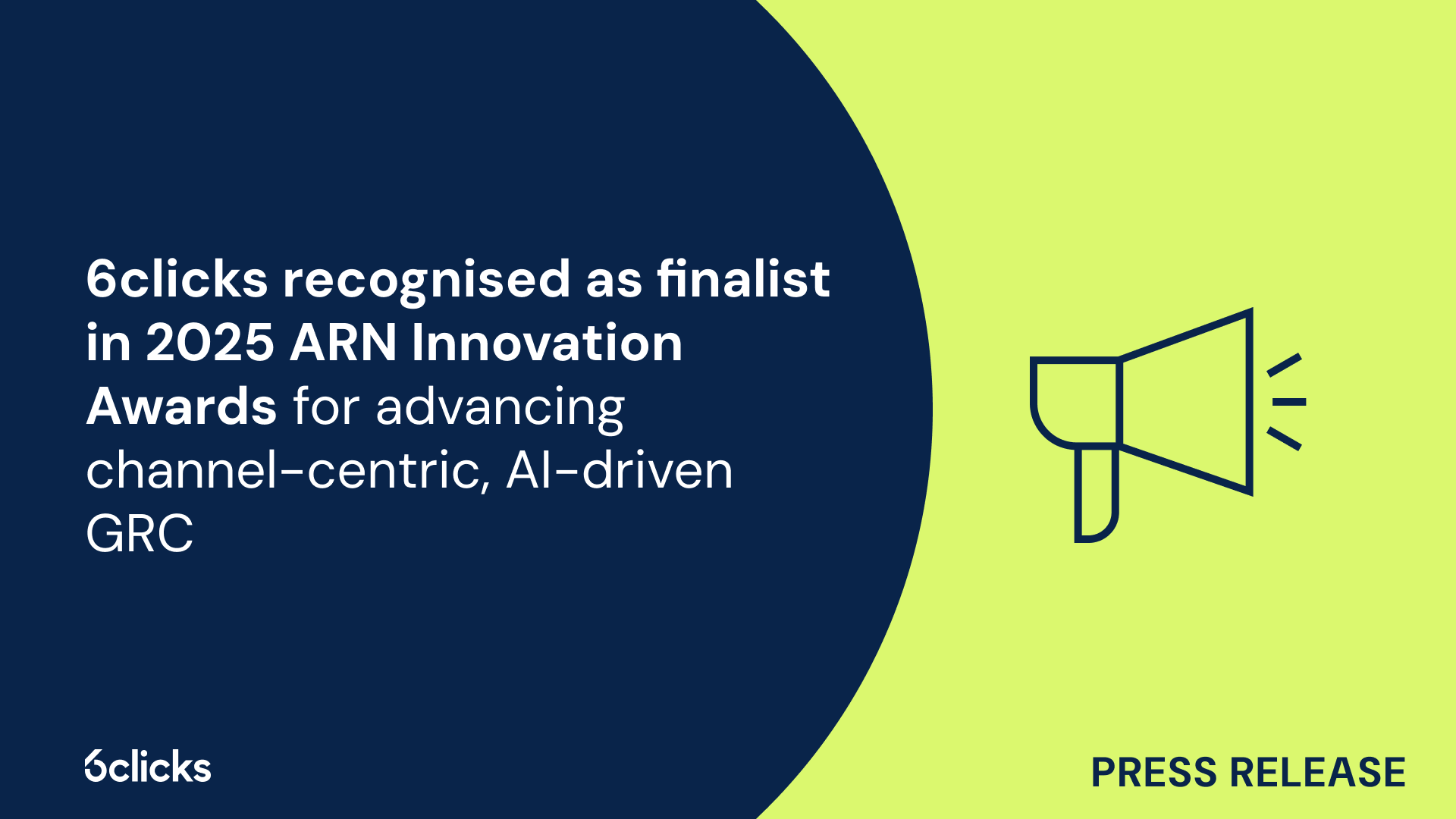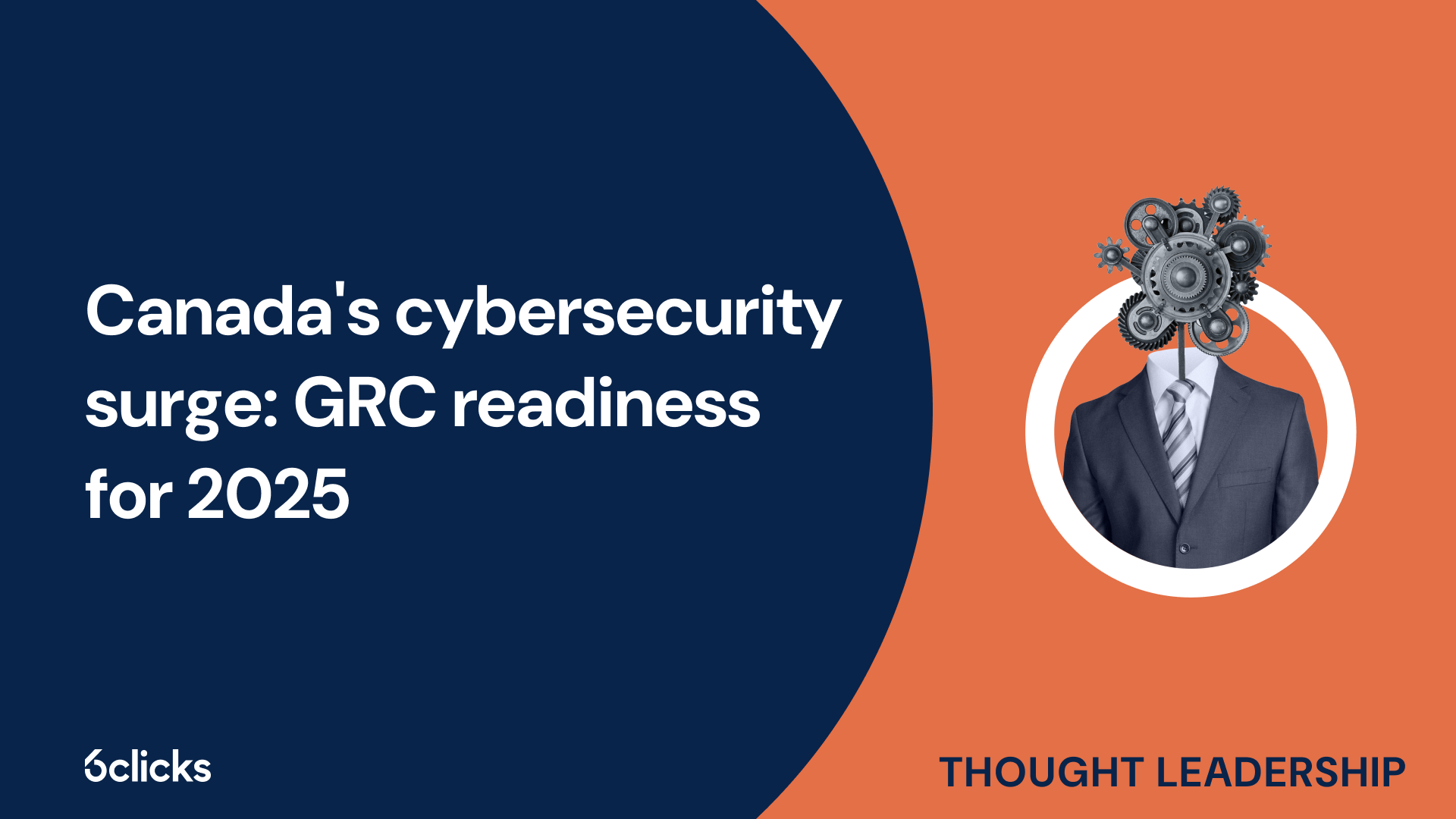Cyber Risk Management Expert Guide
Get the answer to this question "What are the five security risk methodologies?" For risk and compliance leaders from the team at 6clicks
-1.png?width=200&height=249&name=Group%20193%20(1)-1.png)
Cyber Risk Management Expert Guide
What are security risk methodologies?
Security risk methodologies are systematic approaches used to identify, assess, and manage potential threats and risks that can impact an organization's security posture. These methodologies provide a framework for understanding the level of risk, evaluating its potential impact, and implementing appropriate security controls to mitigate or minimize risks to an acceptable level. By conducting security risk assessments, organizations can identify vulnerabilities and potential losses, allowing them to develop a risk treatment plan and make informed decisions to protect their assets, business processes, and entire organization. Security risk methodologies can take both qualitative and quantitative approaches, incorporating various factors such as cyber threats, insider threats, legal requirements, and the organization's risk appetite. These methodologies are typically implemented through risk management processes, involving risk identification, analysis, evaluation, and the development of appropriate risk mitigation options. In order to effectively manage security risks, organizations often use risk registers, risk matrices, and engage risk owners and senior management in the risk treatment process.
The 5 security risk methodologies
There are five commonly used security risk methodologies for conducting risk assessments in cybersecurity and information security management. These methodologies include qualitative risk assessment, quantitative risk analysis, cybersecurity threat modeling, deterministic security risk assessments, and asset-based approach.
- Qualitative Risk Assessment: This methodology assesses risks based on subjective criteria such as likelihood and impact. It is useful when there is limited data and provides a high-level overview of potential risks. However, it may lack accuracy and objectivity in risk analysis. An example of this process is identifying potential threats and their impact on the organization's security posture.
- Quantitative Risk Analysis: This methodology involves assigning numerical values to different risk factors to quantify the level of risk. It provides more accurate and objective risk assessments, considering the probability and potential impact of threats. However, it requires extensive data and expertise to conduct statistical analysis. An example is using mathematical models to calculate the potential losses from a cyber attack.
- Cybersecurity Threat Modeling: This methodology identifies potential threats and their impact, focusing on specific systems or applications. It helps in developing effective security controls and addressing vulnerabilities. It requires expertise in threat modeling techniques but offers a comprehensive understanding of specific security risks. An example is conducting a threat modeling exercise for a new software application, considering potential attack vectors and their impact.
- Deterministic Security Risk Assessments: This methodology analyzes potential risks by considering the cause and effect relationships between threats and security controls. It helps in understanding the effectiveness of existing security controls and developing risk mitigation options. However, it may overlook unforeseen risks and requires detailed knowledge of security controls. An example is evaluating the impact of a network intrusion and analyzing how existing controls could have prevented it.
- Asset-Based Approach: This methodology focuses on identifying and assessing risks based on the criticality of assets within the organization. It aligns security requirements with the business goals and priorities. It helps in prioritizing risk management activities and allocating resources effectively. However, it may overlook interdependencies between assets and their impact on the overall risk posture. An example is conducting a risk assessment based on the criticality of business processes and their dependencies on IT systems.
Each of these methodologies has its advantages and disadvantages, and the choice of methodology depends on the organization's risk management process, risk appetite, and available resources. It is essential to select the most appropriate methodology to ensure a thorough understanding of potential security risks and to develop effective security controls.
Qualitative risk assessment
Qualitative risk assessment is a methodology used to assess risks based on subjective criteria, such as likelihood and impact. This approach is particularly useful when there is limited data available or when conducting a preliminary risk analysis. By providing a high-level overview of potential risks, qualitative risk assessment allows organizations to identify and prioritize their security threats. However, it should be noted that this approach may lack accuracy and objectivity in risk analysis since it relies heavily on expert judgment. Despite its limitations, qualitative risk assessment plays a crucial role in the risk assessment process by identifying potential threats and evaluating their impact on the organization's overall security posture.
Overview of qualitative risk assessment
Qualitative risk assessment is a process used to identify and evaluate the potential risks and threats that an organization may face. It involves the subjective analysis of risks rather than the quantitative measurement of their probabilities and impacts.
The key elements of qualitative risk assessment include the identification of potential risks, the assessment of their probabilities and impacts, and the determination of their relative priorities. This process relies on the expertise and judgment of experienced individuals who evaluate and prioritize the potential risks based on their level of concern and potential impact on the organization.
Perceptions of risk probability and impact are represented in qualitative risk assessment through subjective scales or categories. These scales typically range from low to high, or from negligible to catastrophic, allowing risk assessors to assess the likelihood and severity of each risk.
The advantages of qualitative risk assessment include its simplicity, ease of use, and ability to quickly identify potential risks. It does not require extensive data or complex calculations, making it accessible to organizations with limited resources. Additionally, it encourages engagement from stakeholders and experts who can contribute their insights and knowledge to the risk assessment process.
However, the subjective nature of qualitative risk assessment is also its main disadvantage. It can be influenced by individual biases and interpretations, leading to inconsistent results. Without a standardized approach, it becomes challenging to compare and prioritize risks across different projects or organizations. Furthermore, the lack of quantitative measurements can make it difficult to accurately assess the potential impact and prioritize risk treatment options.
Advantages and disadvantages of qualitative risk assessment
Qualitative risk assessment offers several advantages, including its simplicity and ease of use, allowing for quick identification of potential risks. It does not require extensive data or complex calculations, making it accessible to organizations with limited resources. Additionally, qualitative risk assessment encourages engagement from stakeholders and experts, leveraging their insights and knowledge in the risk assessment process.
However, the subjective nature of qualitative risk assessment can be considered a significant disadvantage. It is highly biased and influenced by individual interpretations, leading to inconsistent results. Without a standardized approach, it becomes challenging to compare and prioritize risks across different projects or organizations. Furthermore, qualitative risk assessment provides a local context understanding, but its applicability outside the organization may be limited. Due to the absence of quantitative measurements, it may be difficult to accurately assess the potential impact of risks and prioritize appropriate risk treatment options.
Example of a qualitative risk assessment process
A qualitative risk assessment process focuses on the probability and impact of potential risks from the perspective of interested parties. This methodology involves identifying potential threats and assessing their likelihood and potential impact on the organization.
During a qualitative risk assessment, risk levels are often evaluated using scales such as "low-medium-high" or "1-2-3-4-5". The probability scale assesses the likelihood of a risk occurring, while the impact scale evaluates the severity of its potential consequences. By assigning values to each risk, a final risk value is determined.
One advantage of qualitative risk assessment is its simplicity and ease of implementation. It provides a broad understanding of risks and helps prioritize them based on their potential impact. It allows organizations to quickly identify and address significant risks.
However, there are disadvantages to qualitative risk assessment. The process heavily relies on subjective judgments and individual interpretations, making it susceptible to biases. The lack of standardized measurements and definitions can lead to inconsistent results and hinder comparisons across projects or organizations. Additionally, without quantitative measurements, accurately assessing the potential impact of risks and prioritizing appropriate risk treatment options can be challenging.
Despite its limitations, qualitative risk assessment provides a valuable initial understanding of the potential risks an organization faces. It should be complemented with other risk assessment methodologies to enhance accuracy and effectiveness in risk management decision-making.
Quantitative risk analysis
Quantitative risk analysis is a methodology used to assess and measure risks using numerical values. Unlike qualitative risk analysis, which relies on subjective judgments, quantitative risk analysis focuses on gathering and analyzing data to calculate the probability and potential impact of risks. This approach allows organizations to quantify risks in terms of monetary value, time, or other measurable units. By doing so, they can prioritize and compare risks more accurately, make data-driven decisions, and allocate resources effectively. However, quantitative risk analysis requires significant data collection and analysis efforts, as well as expertise in statistical analysis and modeling. It may also be more time-consuming and complex to implement compared to qualitative risk analysis. Nonetheless, it provides organizations with a more robust and precise understanding of the potential risks they face, enabling them to develop more informed risk management strategies.
Overview of quantitative risk analysis
Quantitative risk analysis is a methodology used to assess security risks by focusing on factual and measurable data. Unlike qualitative risk assessments, which use subjective criteria, quantitative analysis relies on numerical values to calculate the probability and impact of potential threats. This approach enables organizations to express risks in monetary terms, facilitating decision-making processes.
To determine the risk value in quantitative risk analysis, various concepts are employed. One such concept is the Single Loss Expectancy (SLE), which represents the total potential loss from a single security incident. The SLE is calculated by multiplying the cost of an incident by the probability of that incident occurring.
Another key concept is the Annual Rate of Occurrence (ARO), which quantifies the frequency of a security incident happening within a particular period. By multiplying the SLE by the ARO, organizations can estimate the Annualized Loss Expectancy (ALE), which represents the expected monetary loss per year due to a specific risk.
Quantitative risk analysis provides organizations with a clear understanding of the financial impact associated with identified risks. By conducting a thorough analysis of factual and measurable data, organizations can prioritize resources and allocate budgets accordingly to effectively mitigate potential threats.
Advantages and disadvantages of quantitative risk analysis
Quantitative risk analysis has both advantages and disadvantages in assessing and managing potential security risks.
Advantages:
- Factual and Measurable Data: Quantitative risk analysis relies on factual and measurable data, such as the Single Loss Expectancy (SLE) and the Annual Rate of Occurrence (ARO). This data provides a solid foundation for calculating risk values and making informed decisions.
- Precise Results: One major advantage of quantitative risk analysis is its ability to generate precise results. By assigning numerical values to risks, organizations can accurately quantify the potential impact and prioritize risk treatment efforts accordingly. This ensures that resources are allocated effectively and efficiently.
- Maximum Investment Determination: Quantitative risk analysis allows organizations to determine the maximum amount they can invest in risk treatment. By calculating the potential losses associated with specific risks, organizations can understand the monetary value of mitigating those risks and make decisions based on their risk appetite and available resources.
Disadvantages:
- Limited Accuracy: Quantitative risk analysis heavily relies on historical data and probabilistic models. However, these models may not accurately predict future events. Additionally, gathering and analyzing large amounts of data can be time-consuming and expensive.
- Subjectivity and Assumptions: Despite the use of factual data, quantitative risk analysis still requires assumptions and subjective judgments. These assumptions can introduce bias and affect the accuracy of the results.
- Data Availability and Quality: Quantitative risk analysis heavily depends on the availability and quality of data. If reliable data is not readily accessible, the analysis may be compromised, leading to inaccurate risk assessments.
Example of a quantitative risk analysis process
One effective approach to conducting a quantitative risk analysis is by determining the potential likelihood and impact of each identified risk. This process allows organizations to prioritize risks based on their likelihood and impact scores, ensuring that resources are allocated to the most significant risks first.
To assign a likelihood score, organizations can assess factors such as historical data, industry trends, and expert opinions. For example, if there is a high frequency of cyber attacks in the industry and the organization has experienced similar incidents in the past, the likelihood score may be higher. Likelihood scores can be assigned on a scale from 1 to 10, with 1 indicating a very low likelihood and 10 indicating a very high likelihood.
Similarly, the impact score can be determined by evaluating the potential consequences of each risk. This can include factors such as financial losses, reputational damage, operational disruptions, and legal implications. Again, using a scale from 1 to 10, the impact score reflects the severity of the potential negative impact, with 1 being the least severe and 10 being the most severe.
By combining the likelihood and impact scores, organizations can calculate a risk score for each identified risk. This score helps prioritize risks, with higher scores indicating risks that require immediate attention. Organizations can then use this prioritized list to develop a risk treatment plan and allocate resources accordingly, focusing on mitigating the most significant risks first.
Cybersecurity threat modeling
Cybersecurity threat modeling is a proactive approach taken by organizations to identify, assess, and mitigate potential security risks and threats. By systematically analyzing possible attack vectors and vulnerabilities, threat modeling helps organizations understand their security posture and prioritize security controls and measures. It enables organizations to stay one step ahead of potential cyber threats by identifying weaknesses in their systems and developing strategies to mitigate them. In this article, we will explore five commonly used methodologies in cybersecurity threat modeling that organizations can employ to enhance their security posture and protect their valuable assets from potential cyber attacks. From asset-based approaches to attacker-centric perspectives, these methodologies offer a comprehensive framework to identify and address the potential risks and threats faced by an organization's digital infrastructure.
Overview of cybersecurity threat modeling
Cybersecurity threat modeling is a methodology that helps organizations identify and prioritize potential threats and risks to their information systems and networks. Its primary purpose is to proactively assess the security posture of an organization and develop effective security controls to mitigate potential risks.
The process of cybersecurity threat modeling involves several steps. First, it requires a thorough understanding of the organization's assets, including its IT infrastructure, business processes, and sensitive information. This step, known as risk identification, helps identify potential threats and vulnerabilities.
Next, a qualitative risk assessment is conducted to evaluate the potential impact of these threats on the organization. This assessment considers the likelihood of the threats occurring and the potential losses or negative impacts they could have on the organization's operations.
Following the risk assessment process, the organization determines an acceptable level of risk, known as the risk appetite. This establishes the threshold that the organization is willing to accept in terms of potential risks.
The next step is the development of a risk treatment plan, which outlines the security controls and measures that need to be implemented to reduce the level of risk to an acceptable level. These controls can include technical solutions, policies and procedures, training and awareness programs, and ongoing monitoring and evaluation.
Advantages and disadvantages of cybersecurity threat modeling
Cybersecurity threat modeling offers numerous advantages in identifying potential risks and vulnerabilities in an organization's systems and processes.
One major advantage is that it provides a structured approach to understand the potential threats that an organization may face. By systematically identifying and evaluating potential risks, organizations gain a clearer understanding of the areas where they are most vulnerable. This enables them to prioritize their security measures and allocate resources effectively.
Another advantage is that threat modeling helps organizations develop a proactive security posture. Instead of waiting for incidents to occur, organizations can anticipate potential threats and implement appropriate security controls to mitigate them. This reduces the likelihood and impact of security breaches, protecting valuable assets and preventing financial and reputational damage.
However, there are also some limitations and disadvantages to consider. One limitation is that threat modeling relies on accurate and up-to-date information about potential threats, vulnerabilities, and controls. Without accurate data, the effectiveness of the modeling process may be compromised.
Additionally, threat modeling can be a time-consuming and resource-intensive activity. It requires expertise and collaboration from various stakeholders within the organization to gather information, perform risk assessments, and develop security controls. This may pose challenges, particularly for smaller organizations with limited resources.
Example of a cybersecurity threat modeling process
A comprehensive cybersecurity threat modeling process involves several steps to create a thorough and effective threat model for an organization. Here is an example of the process:
- Identify and Define Assets: The first step is to identify and define the assets that need protection. This includes all information systems, data, applications, and infrastructure components. By clearly defining the assets, the threat modeling process can focus on specific areas of concern.
- Identify and Assess Threats: The next step is to identify and assess potential threats that could harm the identified assets. This involves understanding the various threat actors, their motives, and the tactics, techniques, and procedures they may use to exploit vulnerabilities.
- Identify and Assess Vulnerabilities: Once the threats are identified, the next step is to identify and assess vulnerabilities in the organization's systems and processes. This includes analyzing weaknesses in technology, configurations, access controls, and human factors.
- Analyze Potential Impact: After identifying the threats and vulnerabilities, the potential impact of successful attacks should be analyzed. This includes assessing the potential losses, whether financial, reputational, or operational, that can occur if the identified threats exploit the vulnerabilities.
- Develop Countermeasures: In this step, security controls and countermeasures are developed to mitigate the identified threats and vulnerabilities. These controls may include implementing firewalls, access controls, encryption, employee training, and incident response plans.
Including all components in the threat modeling process is crucial to avoid incomplete models. If any of the steps are skipped or not given proper attention, the threat model may miss critical vulnerabilities or potential attack vectors. For example, if the assessment of threats is not thorough, the organization may overlook emerging cyber threats or insider threats, leaving their systems exposed. Similarly, if the analysis of vulnerabilities is insufficient, the organization may not fully address the weak points in their security posture, making them more susceptible to attacks.
Therefore, it is essential to follow each step diligently and ensure that all components are included to create a comprehensive threat model. This will enable organizations to design effective security controls, prioritize resources, and better protect their assets from potential cybersecurity threats.
Deterministic security risk assessments
Deterministic security risk assessments are a methodical approach used to identify and evaluate potential security risks within an organization. This methodology follows a step-by-step process that incorporates various aspects of the organization to provide a comprehensive understanding of the risks involved.
The steps involved in a deterministic security risk assessment include:
- Asset Identification: Identify and define the assets within the organization that need protection. This includes information systems, data, infrastructure, and any other valuable resources.
- Threat Identification: Identify potential threats that could pose a risk to the identified assets. This involves understanding the motives and capabilities of threat actors and analyzing the various cyber threats that may exist.
- Vulnerability Assessment: Conduct a thorough assessment of the vulnerabilities in the organization's systems and processes. This includes identifying weaknesses in technology, configurations, access controls, and human factors that could be exploited by potential threats.
- Risk Analysis: Analyze the potential impact of successful attacks on the identified assets. This includes assessing the potential losses, both financial and reputational, and the operational impact that can occur.
- Risk Mitigation: Develop and implement security controls and countermeasures to mitigate the identified risks. This may involve implementing firewalls, access controls, encryption, employee training, and incident response plans.
The benefits of conducting deterministic security risk assessments are numerous. This methodology provides a structured and systematic approach to identifying, analyzing, and mitigating risks, allowing organizations to prioritize their security efforts based on the level of risk. By identifying potential threats and vulnerabilities, organizations can take proactive measures to strengthen their security posture and prevent potential attacks. Additionally, deterministic risk assessments help organizations comply with legal and regulatory requirements by ensuring that security controls are in place to protect valuable data.
Deterministic risk assessments differ from other methodologies, such as qualitative and quantitative assessments, in terms of their approach and focus. Qualitative assessments focus on subjective evaluations of risk, often based on expert judgment or predefined risk scales. Quantitative assessments, on the other hand, use mathematical models and measurements to quantify risk in terms of monetary values or probabilities.
Involving all stakeholders in the risk assessment process is crucial for its success. This includes representatives from various business units, IT departments, senior management, and other relevant parties. Each stakeholder brings valuable insights and perspectives that contribute to a holistic understanding of the organization's risk landscape. Additionally, involving stakeholders helps foster a sense of ownership and accountability, ensuring that risk management becomes an organizational-wide responsibility.
Identifying the most valuable data in the organization is also essential in a deterministic risk assessment. By focusing on the data that holds the most importance or sensitive information, organizations can prioritize their efforts in securing and protecting this data from potential threats. This proactive approach helps allocation of resources to areas where they are most needed and ensures the organization's ability to maintain its core functions and reputation.







